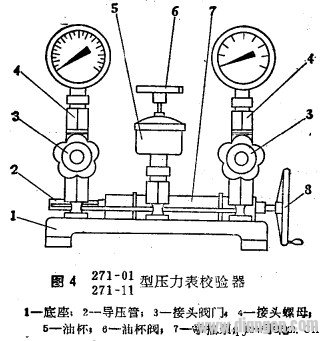1. Place the pressure gauge checker smoothly on the workbench and ensure it is in a stable position. For models like 271-01 and 27-11 (see Figure 4), position it horizontally or vertically depending on the convenience of turning the handwheel. The pressure gauge dial should be facing the operator for easy viewing. To make the inspection and operation more efficient, the standard meter should be installed on the left or rear joint of the checker.

2. Fill the oil cup with a medium to a depth of at least two-thirds. Open the oil cup valve and close the joint valve. Turn the handwheel gently to pump oil into the system. Ensure that the wire length does not reach the end. Once the oil is fully drawn, stop briefly. Then, screw the oil pump slightly back in to release any air that may have been introduced. After that, close the oil cup valve and open both joint valves. At this point, adjust the handwheel to move the medium through the system, allowing you to increase or decrease pressure as required for accurate pressure gauge calibration.
3. After completing the calibration, turn the handwheel down to near the zero position. Open the oil cup valve to completely release any remaining pressure so that the pointer can accurately return to zero. Re-oil the system by shaking the handwheel again. Close the oil cup valve and repeat the process using the same verification method if needed. This ensures consistent and reliable results during each calibration session.
Elevator Components,Elevator Electrical Device,Elevator Frequency Transformer,Elevator Command Board
ZHONG HAN INTERNATIONAL TRADE CO., LTD , https://www.cck-ht.com